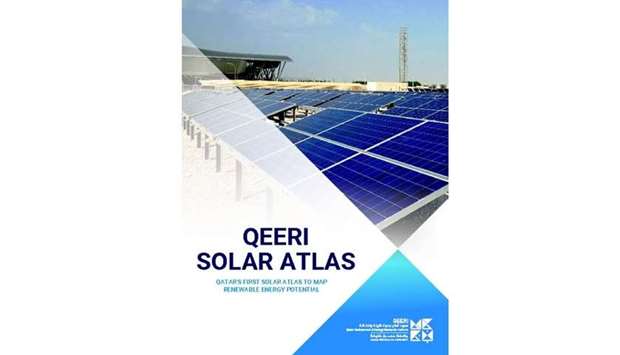Qatar Environment and Energy Research Institute (Qeeri), part of Hamad Bin Khalifa University (HBKU), has released the first Qatar Solar Atlas. The tool quantifies the country’s solar resource and its geographical distribution as a first step toward accelerating the use of more solar energy.
A culmination of research work conducted over the last five years by Qeeri’s Energy Centre, the Solar Atlas aims to support the development of progressive national policies on solar-based sustainable energy. It also aims to identify new profitable investments and markets to drive the creation of “green” jobs and a technological innovation ecosystem.
In doing so, the Solar Atlas will contribute to the Qatar National Vision 2030 and the goals and targets of the Global 2030 Agenda for Sustainable Development. It will serve as an important tool for building a climate-resilient, prosperous, and sustainable future where renewable energy has a significant penetration rate within the country’s energy mix, in a reliable, business-efficient manner.
The comprehensive Solar Atlas includes a vast amount of accumulated data with high time and space resolutions, and sophisticated algorithms to process and convert them into a powerful tool for energy stakeholders in Qatar and beyond.
Dr Veronica Bermudez, senior research director, Energy Centre, explained, “The Atlas presents the results of the solar resource assessment and mapping activities done at the Energy Center at Qeeri. It uses existing ground-measured radiometric data that has been compared with available solar radiation data derived from satellite images in order to generate a model which, after proper validation, has been used to fit satellite data optimally to the local conditions in the country. Qatar is at the heart of the global solar belt and is blessed with abundant solar energy, and the solar map is the first step toward optimising the use of these resources and being able to forecast thermal or photovoltaic electricity production.”
The Solar Atlas combines the use of models, machine learning algorithms, and data to explain the methodologies and outcomes of the solar resource and solar power potential assessment and forecasting. It documents the uncertainty of solar and meteorological data, which are key elements in the technical and financial evaluation of solar energy conversion systems and provides solutions to minimise financial and technological risks.
The other key objective is to improve the awareness and knowledge of resources for solar energy technologies by producing a comprehensive countrywide dataset and maps based on the highly accurate models developed by Qeeri. The Atlas evaluates key solar climatic features, and the geographic and time variability of solar power potential in the country, with solutions to solar and power production forecasting.
Dr Marc Vermeersch, executive director, Qeeri, added, “ Our motivation has always been to assist Qatar in tackling the grand challenges associated with energy and the environment. Our Energy Center, with its expert pool of researchers, scientists, and engineers, along with the state-of-the-art facilities at Qeeri such as the Outdoor Test Facility and the PV Reliability Lab, and our network of 15 solar monitoring stations across Qatar, has persevered to develop this Atlas.”
In doing so, the Solar Atlas will contribute to the Qatar National Vision 2030 and the goals and targets of the Global 2030 Agenda for Sustainable Development. It will serve as an important tool for building a climate-resilient, prosperous, and sustainable future where renewable energy has a significant penetration rate within the country’s energy mix, in a reliable, business-efficient manner.
The comprehensive Solar Atlas includes a vast amount of accumulated data with high time and space resolutions, and sophisticated algorithms to process and convert them into a powerful tool for energy stakeholders in Qatar and beyond.
Dr Veronica Bermudez, senior research director, Energy Centre, explained, “The Atlas presents the results of the solar resource assessment and mapping activities done at the Energy Center at Qeeri. It uses existing ground-measured radiometric data that has been compared with available solar radiation data derived from satellite images in order to generate a model which, after proper validation, has been used to fit satellite data optimally to the local conditions in the country. Qatar is at the heart of the global solar belt and is blessed with abundant solar energy, and the solar map is the first step toward optimising the use of these resources and being able to forecast thermal or photovoltaic electricity production.”
The Solar Atlas combines the use of models, machine learning algorithms, and data to explain the methodologies and outcomes of the solar resource and solar power potential assessment and forecasting. It documents the uncertainty of solar and meteorological data, which are key elements in the technical and financial evaluation of solar energy conversion systems and provides solutions to minimise financial and technological risks.
The other key objective is to improve the awareness and knowledge of resources for solar energy technologies by producing a comprehensive countrywide dataset and maps based on the highly accurate models developed by Qeeri. The Atlas evaluates key solar climatic features, and the geographic and time variability of solar power potential in the country, with solutions to solar and power production forecasting.
Dr Marc Vermeersch, executive director, Qeeri, added, “ Our motivation has always been to assist Qatar in tackling the grand challenges associated with energy and the environment. Our Energy Center, with its expert pool of researchers, scientists, and engineers, along with the state-of-the-art facilities at Qeeri such as the Outdoor Test Facility and the PV Reliability Lab, and our network of 15 solar monitoring stations across Qatar, has persevered to develop this Atlas.”

